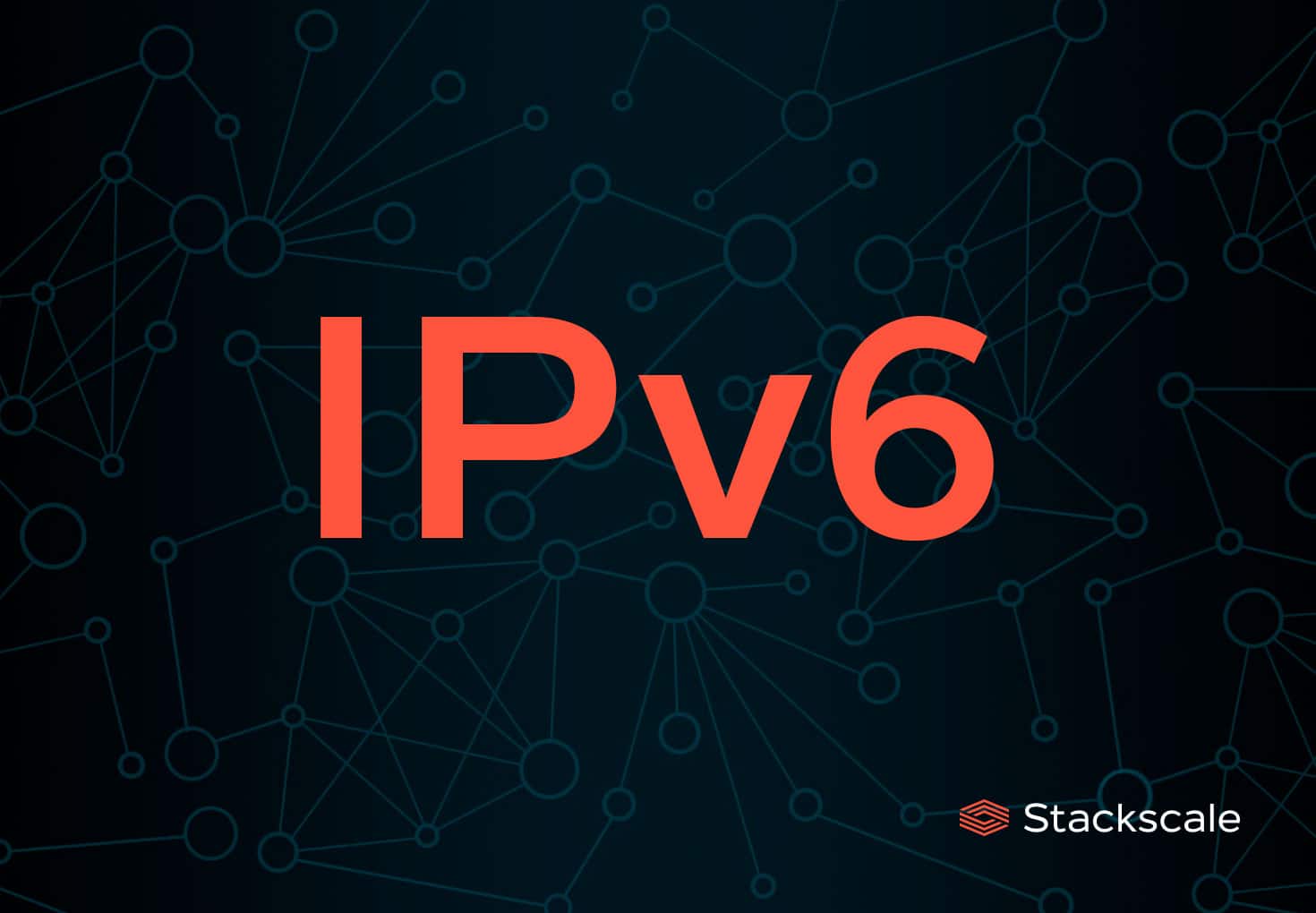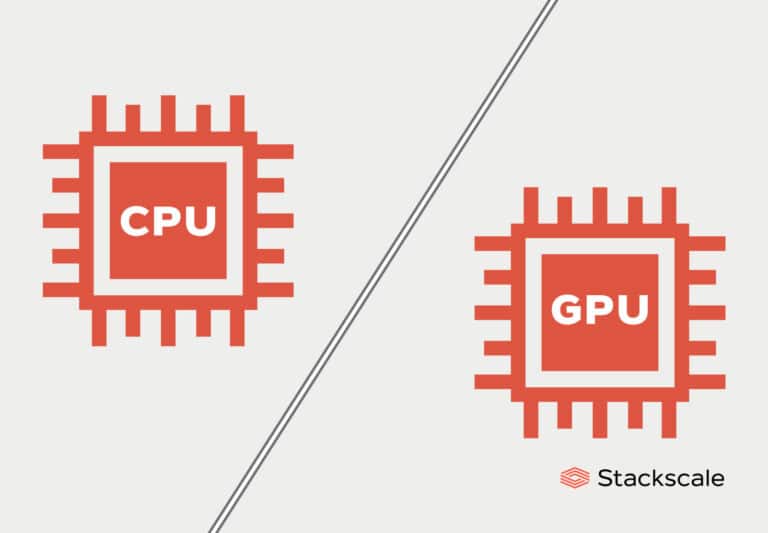The Internet Protocol version 6 or IPv6 is a version of the Internet Protocol (IP). The Internet Protocol allows the transfer of data through a network to IP addresses (IPv4 or IPv6), which identify the different devices that are connected to the Internet, allowing communications among them.
IPv6 should end up replacing IPv4.
The transition to IPv6 is necessary for technological advances, especially in light of the exponential growth of connected devices derived from the development of the Internet of Things (IoT). Besides, the IPv6 protocol presents significant improvements in terms of efficiency, performance and security.
From the beginning, Stackscale has been a leader in the implementation of IPv6 on its network, offering the possibility to deploy services to all customers on this new protocol.
How is an IPv6 address?
One of the biggest changes of IPv6 compared to IPv4 is the length of the network addresses. IPv6 addresses have 128 bits, it is to say, 32 hexadecimal digits. This is an important improvement against IPv4 addresses, which has 32 bits. Moreover, IPv6 addresses can be composed of two logical parts: a 64-bit prefix and a 64-bit interface identifier.
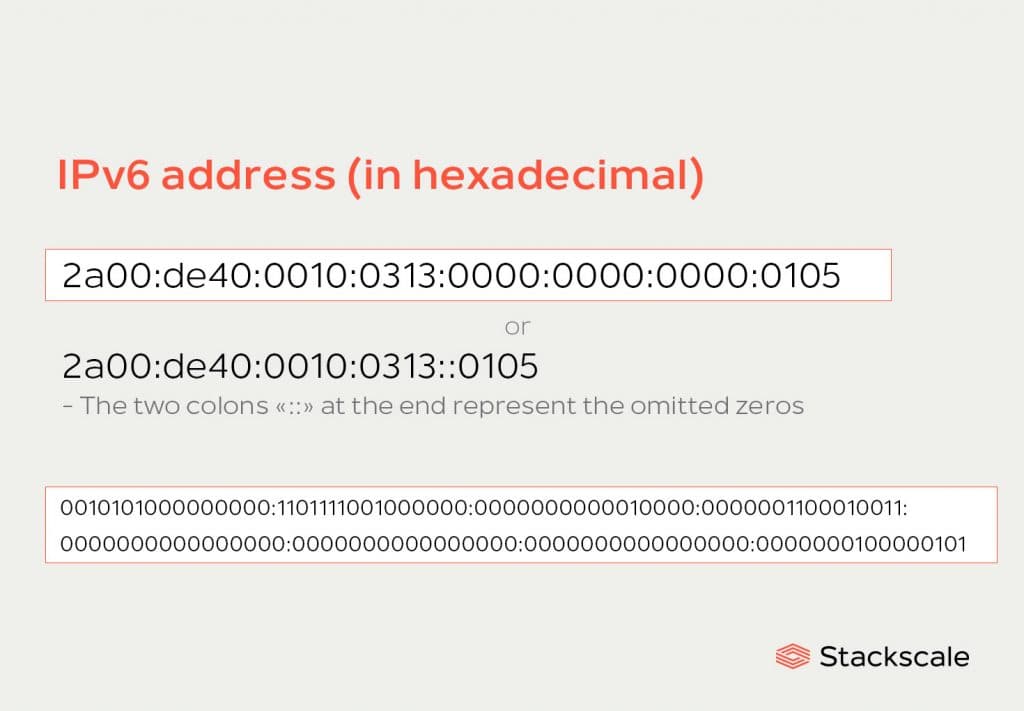
The interface identifier is almost always generated automatically based on the MAC address of the interface to which the address is assigned. This is one of the advantages of implementing it on the IoT, because it provides a unique IP address to every connected device.
Advantages of the IPv6 protocol
These are some of the advantages of this new protocol of IP addresses, IPv6.
A nearly unlimited number of unique IP addresses
This new protocol enables every device connected to the Internet to have its own IP address. An advantage that is slowly becoming a requirement due to the constant development of the Internet of Things. Therefore NAT (Network Address Translation) is no longer necessary.
Native support for mobile devices
IPv6 supports the mobile IPv6 protocol, MIPv6. This protocol allows mobile devices to change from one network to another and to receive itinerary notifications regardless of their physical location.
Autoconfiguration
The new protocol includes better methods to do automatic configurations, bringing a significant improvement in comparison with the classic DHCP used in IPv4.
Security
IPv6 can be improved with IPsec (Internet Protocol Security) in order to manage encryption and authentication between hosts. This new protocol provides a strong end-to-end security framework for data transfer. However, since RFC 6434, support for IPsec is only recommended, instead of mandatory, as it was specified in RFC 4292. To benefit from its authentication and encryption features, IPsec must be actively applied.
Efficiency
Package management is much more efficient in IPv6 because it simplifies packet header. IPv6 also makes routing more hierarchical and efficient by reducing the size of routing tables.
IPv4 vs. IPv6
The Internet Protocol version 4 or IPv4 is the first version of the Internet Protocol, deployed for production in ARPANET in 1983. IPv4 is currently the most widespread IP version globally. Nevertheless, since 2010 the end of IPv4 addresses has become a source of concern. That is why IPv6 was defined in the RFC 2460 with the aim of replacing the “exhausted” IPv4, RFC 791.
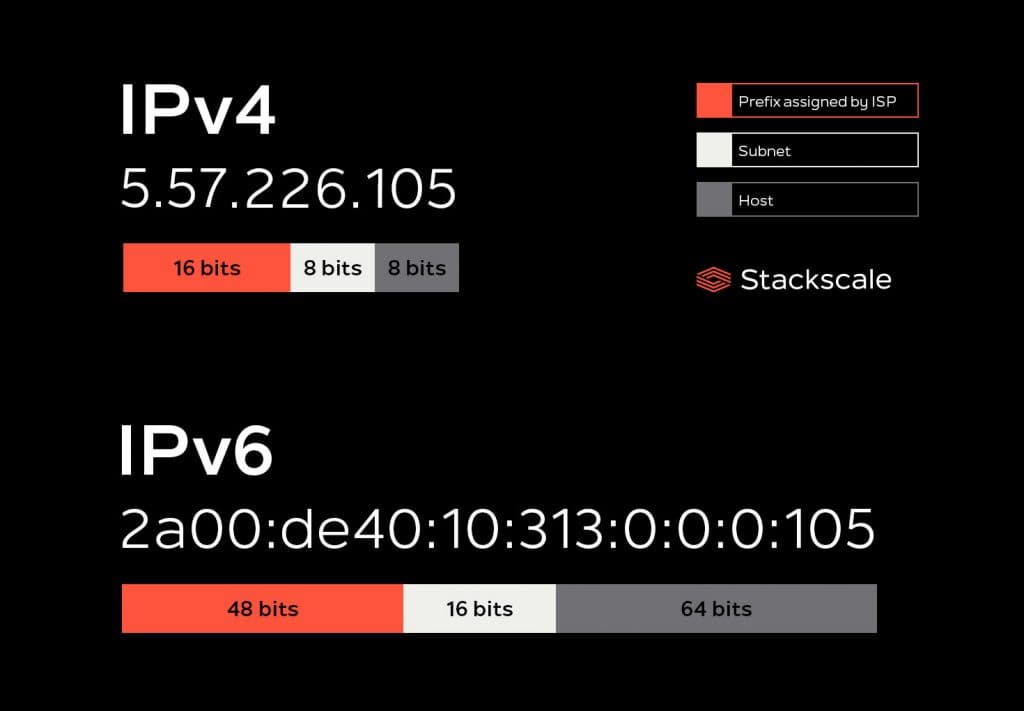
The design of IPv6 was in charge of Steve Deering of Xerox PARC and Craig Mudge. The goal was to increase the number of IP addresses available on the Internet. Since 2016, IPv6 has started to be implemented in most devices connected to the Internet.
What is the problem with the IPv4 protocol?
The problem with the current protocol, IPv4, is the limit of IP addresses it allows — a maximum of about 4.300 million unique IP addresses.
- IANA’s global stock of available IPv4 addresses was depleted in 2011.
- RIPE ran out of IP addresses in November 2019.
The new standard IPv6 is born not only to be able to provide a unique IP address to each device connected to the Internet, but also to improve the Internet service globally.
IPv4 allows 4.294.967.296 different host addresses. This number of IP addresses is completely insufficient for assigning an address to each person on Earth. Thus much less to assign one to each device connected to the Internet nowadays and in the future.
However, IPv6 allows 340.282.366.920.938.463.463.374.607.431.768.211.456 (2128 or 340 sextillions of addresses) — nearly 6,7 x 1017 (670 quadrillion) addresses per square millimeter of the Earth’s surface. This is, undoubtedly, one of the keys that will force the real and massive adoption of the IPv6 protocol.
Differences between IPv4 and IPv6
Although both IPv4 and IPv6 are used to identify machines connected to a network, there are many differences between both protocols. These are some of them:
- IP address’ size
- IPv4: 32 bits
- IPv6: 128 bits
- Addressing method
- IPv4: numeric and binary bits separated by a dot (.).
- IPv6: alphanumeric and binary bits separated by a colon (:).
- Classes of IP addresses
- IPv4: five different classes of IP addresses.
- IPv6: a nearly unlimited number of IP addresses. Moreover, it includes support for ranges considered as “private”.
- Configuration
- IPv4: each system must be configured in order to communicate with others. The network is also set up manually or using DHCP.
- IPv6: optional configuration depending on the functions needed and it supports autoconfiguration between IPv6 devices.
- Interoperability
- IPv4: network topologies are rather restricted, with limited interoperability and mobility capabilities.
- IPv6: interoperability and mobility capabilities included in network devices.
How many IP addresses are there in an IPv4 /24 and in an IPv6 /64?
The number after the slash (/) is the size of the block assigned to an IP address. This indicates the number of IP addresses within the block. The higher the number after the slash, the lower the number of IP addresses contained in the block and vice versa.
IP addresses in an IPv4 /24
In an IPv4 /24 there are 256 IPv4 addresses. /24 means that the first 24 bits out of the 32 bits of the IPv4 address are defined by the network. The 8 bits left are defined by the host.
The biggest block that can be assigned to an IPv4 is /8; these are the blocks assigned to regional registers such as ARIN or LACNIC. For example, an IPv4 /8 has 16.777.216 IP addresses. The smallest block that can be assigned to an IPv4 is /32, which corresponds to a unique IP address.
Examples of allocations in IPv4
| Prefix | IPv4 addresses | Mask |
| /32 | 1 (20) | 255.255.255.255 |
| /24 | 256 (28) | 255.255.255.0 |
| /16 | 65.536 (216) | 255.255.0.0 |
| /8 | 16.777.216 (224) | 255.0.0.0 |
IP addresses in an IPv6 /64
In an IPv6 /64 there are 18.446.744.073.709.551.616 IPv6 addresses. /64 is the default prefix for IPv6 addresses. /64 means that the first 64 bits out of the 128 bits of the IPv6 are defined by the network. The 64 bits left are defined by the host. In IPv6, the minimum block allocated to ISPs by regional and national registers is /32.
IPv4 pools state per zones
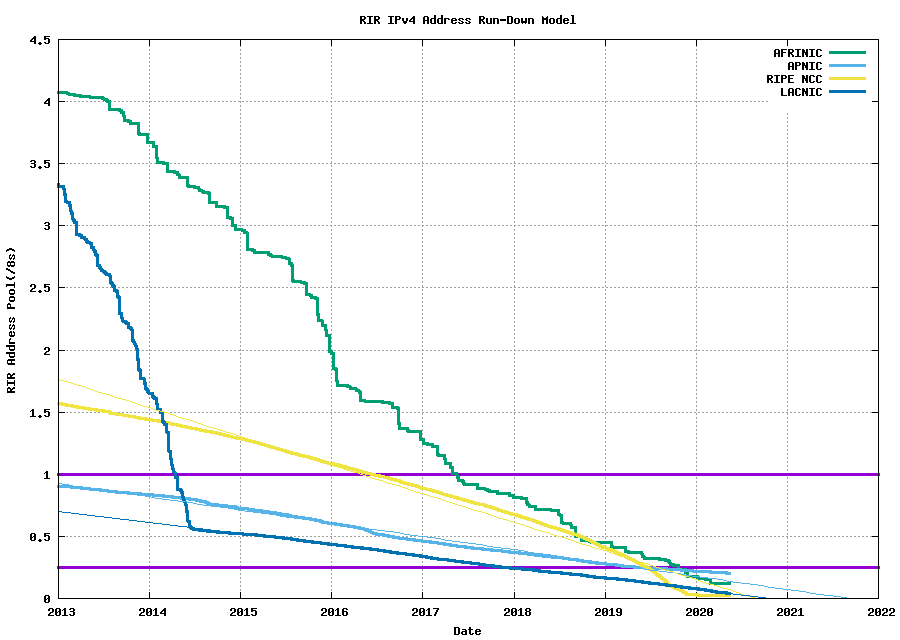
Source: potaroo
The graphic above shows how IPv4 ranges have been exhausted at a fast rate in all regions. Even so, the popularization of the IPv6 protocol is advancing too slowly. One of the reasons is the slow adoption of IPv6 by ADSL and Fiber optics providers, who should be the main responsible organizations to ensure its adoption so that all users start navigating natively with the new protocol
Transition from IPv4 to IPv6 by region
The deployment and adoption of IPv6 differs considerably among regions and countries worldwide. Here is a list of the IPv6 capable rates by region, according to data from APNIC Labs (as of January 2023).
| Region | IPv6 deployment rate |
| North America | 52.35% |
| Central America | 41.88% |
| Asia | 37.40% |
| Oceania | 31.81% |
| South America | 30.92% |
| Europe | 28.03% |
| Africa | 1.54% |
IPv6 adoption in North America
| Country | IPv6 deployment rate |
| United States | 54.82% |
| Canada | 36.34% |
IPv6 adoption in Central America
IPv6 adoption rates vary significantly within Central America. While the adoption is about 40% in some countries like Mexico (48.70%) and Guatemala (37.09%), the rate is much lower in other countries like Costa Rica (4.63%) and Panama (1.83%).
| Country | IPv6 deployment rate |
| Mexico | 48.70% |
| Guatemala | 37.09% |
| Nicaragua | 15.41% |
| El Salvador | 9.70% |
| Belize | 6.08% |
| Honduras | 5.36% |
| Costa Rica | 4.63% |
| Panama | 1.83% |
IPv6 adoption in Asia
IPv6 adoption rates vary significantly within Asia. While the adoption rate in some countries is above 50% — India (78.12%), Malaysia (60.15%) and Saudi Arabia (60.09%) — other countries do not even reach 1% — Iran (0.44%), Qatar (0.32%) and Cambodia (0.06%), among others.
| Country | IPv6 deployment rate |
| India | 78.12% |
| Malaysia | 60.15% |
| Saudi Arabia | 60.09% |
| Myanmar | 56.87% |
| Israel | 51.37% |
| Vietnam | 49.30% |
| Taiwan | 49.14% |
| Sri Lanka | 49.06% |
| Japan | 46.55% |
| United Arab Emirates | 45.70% |
| Thailand | 42.85% |
| Nepal | 34.09% |
| Macao Special Administrative Region of China | 28.25% |
| China | 27.64% |
| Singapore | 20.35% |
| Bhutan | 19.39% |
| Republic of Korea | 17.33% |
| Kuwait | 17.27% |
| Oman | 15.96% |
| Philippines | 15.26% |
| Jordan | 14.00% |
| Indonesia | 13.00% |
| Georgia | 12.54% |
| Kazakhstan | 7.73% |
| Mongolia | 4.72% |
| Pakistan | 3.82% |
| Hong Kong Special Administrative Region of China | 3.39% |
| Armenia | 3.36% |
| Bangladesh | 2.98% |
| Turkey | 1.93% |
| Lebanon | 0.99% |
| Iran | 0.44% |
| Uzbekistan | 0.42% |
| Syrian | 0.40% |
| Laos | 0.35% |
| Qatar | 0.32% |
| Bahrain | 0.20% |
| Afghanistan | 0.15% |
| Iraq | 0.14% |
| State of Palestine | 0.09% |
| Brunei | 0.08% |
| Yemen | 0.07% |
| Azerbaijan | 0.06% |
| Maldives | 0.06% |
| Cambodia | 0.06% |
| Kyrgyzstan | 0.05% |
| Timor-Leste | 0.05% |
| Tajikistan | 0.04% |
| Turkmenistan | 0.00% |
IPv6 adoption in Oceania
IPv6 adoption rates vary significantly within Oceania. While the adoption is above 20% in countries like Australia (37.63%) and New Zealand (24.37%), countries like Tonga (0.64%), Fiji (0.09%) or Samoa (0.03%) do not reach 1%.
| Country | IPv6 deployment rate |
| Australia | 37.63% |
| New Zealand | 24.37% |
| Papua New Guinea | 5.96% |
| Tonga | 0.64% |
| Marshall Islands | 0.33% |
| Micronesia | 0.12% |
| Vanuatu | 0.10% |
| Fiji | 0.09% |
| Nauru | 0.04% |
| Solomon Islands | 0.04% |
| Cook Islands | 0.03% |
| Samoa | 0.03% |
| Kiribati | 0.02% |
| Palau | 0.01% |
| Tuvalu | 0.00% |
IPv6 adoption in South America
IPv6 adoption rates vary significantly within South America. While the adoption is above 40% in some countries like Uruguay (56.30%) and Brazil (40.98%), the rate is much lower in other countries like Chile (15.81%), Guyana (13.52%) and Venezuela (0.97%).
| Country | IPv6 capable rate |
| Uruguay | 56.30% |
| Brazil | 40.98% |
| Paraguay | 30.14% |
| Peru | 28.21% |
| Colombia | 24.83% |
| Suriname | 24.07% |
| Ecuador | 23.39% |
| Argentina | 19.81% |
| Bolivia | 16.76% |
| Chile | 15.81% |
| Guyana | 13.52% |
| Venezuela | 0.97% |
IPv6 adoption in Europe
IPv6 adoption rates vary significantly within Europe. While the adoption rate in some countries is close to 50% or even above — Belgium (67.28%), France (61.47%) and Germany (59.87%) — other countries are far below 10% — Lithuania (0.20%), Spain (4.31%) and Croatia (6.01%), among others.
| Country | IPv6 deployment rate |
| Belgium | 67.28% |
| France | 61.47% |
| Germany | 59.87% |
| Greece | 58.96% |
| Finland | 51.01% |
| Luxembourg | 46.72% |
| Hungary | 45.79% |
| Netherlands | 44.69% |
| United Kingdom | 44.06% |
| Portugal | 42.85% |
| Switzerland | 38.62% |
| Estonia | 38.04% |
| Austria | 33.18% |
| Romania | 29.28% |
| Norway | 26.00% |
| Liechtenstein | 24.53% |
| Ireland | 24.26% |
| Czech Republic | 19.33% |
| Poland | 16.85% |
| Slovenia | 14.06% |
| Latvia | 13.43% |
| Belarus | 12.57% |
| Sweden | 11.56% |
| Iceland | 11.63% |
| Moldova | 11.00% |
| Slovakia | 9.34% |
| Denmark | 8.77% |
| Bulgaria | 8.54% |
| Bosnia and Herzegovina | 8.43% |
| Ukraine | 8.01% |
| Albania | 7.27% |
| Italy | 6.86% |
| Serbia | 6.79% |
| Croatia | 6.01% |
| Russia | 5.89% |
| Spain | 4.31% |
| Monaco | 0.84% |
| Cyprus | 0.21% |
| Lithuania | 0.20% |
| Andorra | 0.16% |
| Malta | 0.08% |
| San Marino | 0.04% |
| Montenegro | 0.03% |
| North Macedonia | 0.03% |
IPv6 adoption in Africa
IPv6 adoption rates vary significantly within Africa. While the adoption is about 20% in countries like Togo (22.78%) and Gabon (20.07%), countries like Nigeria (0.34%), Equatorial Guinea (0.19%) or Senegal (0.04%) do not reach 1%.
| Country | IPv6 capable rate |
| Togo | 22.78% |
| Gabon | 20.07% |
| Congo | 15.24% |
| Rwanda | 10.90% |
| Zimbabwe | 9.04% |
| Kenya | 6.14% |
| South Africa | 4.02% |
| Burkina Faso | 3.88% |
| Egypt | 3.63% |
| Seychelles | 2.65% |
| Democratic Republic of the Congo | 1.51% |
| Côte d’Ivoire | 0.88% |
| Nigeria | 0.34% |
| Mali | 0.34% |
| Tanzania | 0.30% |
| Lesotho | 0.24% |
| Equatorial Guinea | 0.19% |
| Somalia | 0.16% |
| Uganda | 0.13% |
| South Sudan | 0.13% |
| São Tomé and Príncipe | 0.10% |
| Sudan | 0.10% |
| Libya | 0.09% |
| Ethiopia | 0.08% |
| Central African Republic | 0.07% |
| Madagascar | 0.06% |
| Angola | 0.05% |
| Algeria | 0.05% |
| Gambia | 0.05% |
| Cape Verde | 0.05% |
| Senegal | 0.04% |
| Chad | 0.04% |
| Mauritania | 0.04% |
| Eswatini | 0.04% |
| Burundi | 0.04% |
| Botswana | 0.04% |
| Mauritius | 0.04% |
| Namibia | 0.04% |
| Ghana | 0.04% |
| Benin | 0.03% |
| Zambia | 0.03% |
| Morocco | 0.03% |
| Tunisia | 0.03% |
| Mozambique | 0.03% |
| Cameroon | 0.03% |
| Guinea-Bissau | 0.02% |
| Djibouti | 0.02% |
| Malawi | 0.02% |
| Niger | 0.02% |
| Sierra Leone | 0.02% |
| Liberia | 0.02% |
| Comoros | 0.02% |
| Guinea | 0.02% |
| Eritrea | 0.00% |
What about IPv5?
IPv5 was defined in 1979, but it was only experimental. That version of the Internet Protocol could not replace IPv4 because the number 5 was already allocated. IPv5 was also known as the “Internet Stream Protocol”.
IPv6 protocol at Stackscale
Stackscale supports IPv6 since its foundation. All our customers can have an IPv6 addressing free of charge. Several million IPs of exclusive use; particularly a range /64 which is 2 raised to the power of 64, which represents 18.446.744.073.709.551.616 IPv6 addresses.

